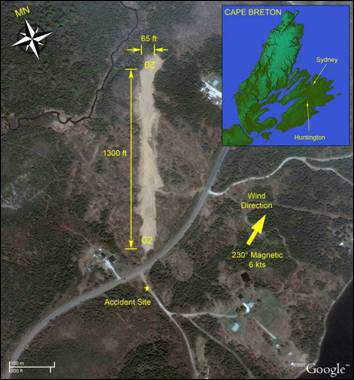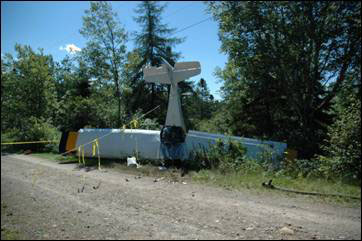Loss of Control - Stall/Spin
Kitfox IV C-GCSU
Huntington, Nova Scotia
The Transportation Safety Board of Canada (TSB) investigated this occurrence for the purpose of advancing transportation safety. It is not the function of the Board to assign fault or determine civil or criminal liability. This report is not created for use in the context of legal, disciplinary or other proceedings. See Ownership and use of content. Masculine pronouns and position titles may be used to signify all genders to comply with the Canadian Transportation Accident Investigation and Safety Board Act (S.C. 1989, c. 3).
Summary
The amateur-built Denney Kitfox IV, a single-engine tail-wheel configured aircraft (registration C-GCSU, serial number C-9404-0022) had departed from a private airstrip on a local flight near the community of Huntington, Nova Scotia. The aircraft flew in the local area for approximately 15 minutes until a local resident heard the sound of impact at approximately 1130 Atlantic daylight time. There were no eyewitnesses to the accident. Within minutes of the impact, the aircraft was found along the edge of the access road to the pilot's residence. The pilot was critically injured and was transported to hospital. The aircraft came to rest directly along the extended centreline of Runway 20 of the private airstrip, about 275 feet beyond the departure end. The aircraft was destroyed and there was no fire.
Factual information
The pilot was certified and qualified for the flight in accordance with existing regulations. He had accumulated approximately 282 hours of total time since he began flying in 1989, primarily on Cessna 150 and 172 aircraft. After acquiring a private pilot licence, he had flown 10 to 14 hours per year as pilot-in-command (PIC) until 1996, but very little between 1997 and 2007.
The pilot acquired C-GCSU and, because he had no previous tail-wheel aircraft experience, he enlisted an experienced Kitfox pilot/owner, who had approximately 700 hours on type, to provide him with some familiarization training on type in October 2007. The training, which included some stall practice, went well and they accumulated 13.2 hours of training in C-GCSU. The pilot then completed a 4.3-hour solo cross-country flight to Sydney Airport (CYQY). On 02 November 2007, the pilot flew the aircraft from CYQY to his private strip in Huntington; this was the last flight before the accident approximately 10 months later. This period of inactivity was due primarily to unsuitable weather/runway conditions.
On the day of the flight, the pilot intended to conduct some practice in the local area. The sky was clear and the wind direction was approximately 230 degrees magnetic at less than 10 knots. The dirt airstrip runway orientation is 200 degrees/020 degrees magnetic and it is approximately 1300 feet long and 65 feet wide (See Photo 1). The pilot conducted a take off from Runway 20 and then flew in a south-southwest direction. The time of departure was estimated as approximately 1115Footnote 1. A local resident heard the aircraft fly over and heard the sound of impact shortly after. Once the aircraft was located and the pilot extracted from the wreckage, the 911 emergency service was called at 1139 Atlantic daylight time. The local volunteer fire department, local police, and an ambulance attended the scene. The pilot was stabilized and transported to the local hospital, eventually being airlifted to a hospital in Halifax due to the extent and severity of his injuries. Those injuries restricted his ability to recall any significant details of the accident flight.
The aircraft contacted the ground in a direction of travel between 200 and 205 degrees magnetic, close to vertical, with the right wing contacting the ground slightly before the left wing. The aircraft bounced once and then came to rest on its nose about six feet from the initial impact point. The ground contact marks also showed some rotation to the right about the longitudinal axis. The trees surrounding the site were undamaged as were the hydro cables along the road, indicating a near vertical descent. The forward section of the aircraft collapsed and the engine folded up and inward toward the instrument panel, moving rearward into the cockpit area. Little space remained in the cockpit; the pilot's upper body was forced out through the left hand entry door, which had sprung open during the impact.
The aircraft impact orientation (See Photo 2) and airframe damage was consistent with a steep nose down inverted attitude typical of a low-altitude aerodynamic stall/spin eventFootnote 2. The accident aircraft was not equipped with a stall warning device, nor is one required for this category of aircraft.
Examination of the technical records indicated construction was completed and the aircraft flown for the first time in July 1998. According to the technical logbook, the aircraft was maintained in accordance with the aircraft manufacturer's manual. C-GCSU had flown approximately 339.3 hours since entering service.
The aircraft was powered by a NSI Propulsion Systems IncFootnote 3 engine (model EA-81, serial number A12230). The EA-81 is a horizontally opposed, four cylinder, liquid cooled, carbureted engine specifically designed for the amateur aircraft market. It is capable of producing approximately 110 horsepower. The engine was examined at the TSB Regional wreckage examination facility. No discrepancies were evident that would contribute to a momentary interruption in power or a complete engine stoppage. Engine control continuity was established; the throttle was in the full open position, the mixture was full rich, and carburetor heat was off.
The aircraft was equipped with a Warp Drive three blade, fixed pitch, ground adjustable composite propeller (serial number H6417). During the impact, all three propeller blades detached from the hub and all the blades were found within 25 feet of the aircraft. The damage to the propeller indicated moderate engine power at impact.
The ground under the aircraft was fuel soaked, each fuel tank contained a small quantity of fuel, and both fuel valves were in the "flow" position. There was fuel present in the main feed line to the carburetor, indicating fuel exhaustion was not a factor.
The flight control cables and push-pull rods were connected to their respective control surfaces and it was determined that control continuity was not compromised. The full span flaperonsFootnote 4 were extended approximately five degrees at the time of impact.
According to Transport Canada records for C-GCSU, the maximum take-off weight (MTOW) for the aircraft was 1200 pounds, and the aircraft empty weight was listed as 741 pounds. It was determined that the aircraft, with the pilot and full fuel on board, would have been within the MTOW and within the allowable centre of gravity range.
An emergency locator transmitter (ELT), manufactured by ACK Technologies (part number E 01-01, serial number 010171) had been installed on a removable panel in the tail section of the aircraft. During the impact, the panel-mounted ELT separated from the aircraft and was found in the centre of the driveway, approximately 20 feet from the aircraft. The ELT was undamaged other than being torn from the antenna coax cable. The ELT switch was found in the OFF position.
The published power-on stall speed for the Kitfox IV is 34 mph with full flaperon deflection and an engine similar to the one in C-GCSU. A stall speed for zero flaperon deflection is not given. Pilots who have flown the Kitfox IV indicate that it has reasonable stall characteristics without the tendency to drop a wing during the exercise.
Analysis
With no eyewitness accounts and without the pilot being able to recall any significant moments of the accident flight, investigators had to rely on an analysis of information from the accident site and the pilot's experience/currency to determine the most likely cause of the accident.
The aircraft's impact orientation indicates there was a departure from controlled flight, resulting from a stall/spin scenario. The stall/spin scenario was not a result of a structural failure in flight, no engine or control anomalies were noted during the wreckage examination, the weather was determined not to be a factor, and a stall/spin scenario would not have been deliberately initiated at such a low altitude. The most likely scenario leading to the accident would be the pilot's lack of currency and inexperience on type, leading to a failure to detect the symptoms of an approaching stall and apply the appropriate corrections in a timely manner, resulting in an unintentional stall/spin situation. Once the aircraft had departed controlled flight, there was insufficient altitude to recover. Within seconds, the flight profile would have changed from horizontal to vertical with the aircraft contacting the ground shortly after.
It could not be determined exactly where the pilot had flown or what manoeuvres had been conducted after departure. Although the wind was light, it favoured Runway 20 and this would likely have been the direction used for takeoff and landing. The location of the accident site on the extended runway centreline, 275 feet from the departure end, would suggest the initiating event occurred shortly after takeoff from Runway 20, in the initial climb out, after a practice touch and go. Other possible scenarios included: an approach to landing on Runway 02 with a tailwind; low level manoeuvring while observing the ground; and overflying the strip after an aborted landing. But these were all considered to be less likely.
The pilot was inexperienced on this aircraft type and was not very familiar with the symptoms that it would display prior to a stall. The pilot was inexperienced on tail-wheel aircraft handling and had not flown this aircraft from his airstrip prior to this flight. During the course of a practice touch and go, the pilot would have been preoccupied with controlling the aircraft directionally on the ground and initial climb out. It is possible that due to this distraction, the pilot's unfamiliarity with the aircraft, and the lack of a stall warning device, the decreasing airspeed in the climb and the approaching stall symptoms may have been missed. With a low airspeed, a high angle of attack, and the engine at climb power, if a stall occurred, a right wing drop and associated spin is likely. Based on the location of the crash site, the proximity of the aircraft to the surrounding trees and power wires, an indication of right-hand rotation at impact, and the aircraft's orientation make this scenario the most plausible.
The onset of the stall would likely have been abrupt and without warning, leaving little time or altitude to effect a recovery. In this accident, if the aircraft was so equipped, a stall warning horn may have sounded early enough to give the pilot time to take action to avoid the stall.
The pilot survived his extensive injuries as a result of timely medical care because a local resident heard the impact and quickly located the accident site.
Findings
Findings as to causes and contributing factors
- The pilot was inexperienced on the aircraft type and had not flown it in the previous ten months; he may have been unfamiliar with the symptoms of an impending aircraft stall and the proper corrective action.
- The aircraft was operating at the departure end of Runway 20 at low altitude when it stalled and entered an incipient spin from which there was insufficient height to recover before it collided with terrain.
Findings as to risk
- In the absence of a stall warning device on amateur-built aircraft, pilots may not be able to detect an impending stall.
- With an emergency locator transmitter (ELT) switch in the OFF position during an aircraft accident, it is possible that a seriously injured pilot might succumb to injuries before help arrives.
This report concludes the Transportation Safety Board's investigation into this occurrence. Consequently, the Board authorized the release of this report on .

